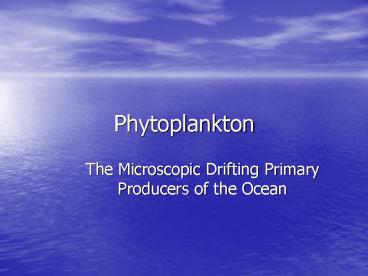Phytoplankton - PowerPoint PPT Presentation
1 / 24
Title:
Phytoplankton
Description:
Phytoplankton. The Microscopic Drifting Primary Producers of the Ocean ... Restricted to the photic zone...Why? Adaptations for Phytoplankton Success ... – PowerPoint PPT presentation
Number of Views:1165
Avg rating:3.0/5.0
Title: Phytoplankton
1
Phytoplankton
- The Microscopic Drifting Primary Producers of the
Ocean
2
4 Categories of Phytoplankton
- Picoplankton - lt than 2 micrometers
- Ultraplankton 2-5 micrometers
- Nannoplankton 5-20 micrometers
- Microplankton 20 200 micrometers
- -Remember that 1,000,000 micrometers is equal
to one meter. - -Nannoplankton are the size of most plankton
in the oceans
3
Cyanobacteria
4
Cyanobacteria Characteristics
- Photosynthetic bacteria that use chlorophyll and
release oxygen. - Very smallmost are picoplankton or
ultraplankton. - Found in intertidal and estuarine environments.
- Some can bloom in warm waterThe red pigment from
Oscillatoria is why the Red Sea is called red. - Not visible unless clumped together to form
microbial mats, which can form stromatolites.
5
Oscillatoria and the Red Sea
6
Stromatolites and Microbial Mats
7
Division Chrysophyta
- Single celled eukaryotes.
- Members of the Protist Kingdom.
- Many different colored pigments found
- Includes the golden-brown algae,
coccolithophores, and the diatoms.
8
Coccolithophores
- Unicellular with many calcareous plates
(coccoliths) embedded in their cell wall
9
Diatoms
10
Diatom Characteristics
- The most abundant members of the phytoplankton.
- Usually unicellular but can form chains.
- Cell size between 15 micrometers and 1
millimeter. - Cell wall (frustule) mostly made up of silica.
- Can be found at any level in the ocean that light
can reach.
11
Division Dinophyta
- Most are photosynthetic and are most commonly
found in warm oceans. - Unicellular, large nucleus, 2 flagella and most
between 25 and 1000 micrometers. - Blooms are common.
- Some are bioluminescent.
12
Dinophytes
13
Bioluminescent Dinophytes
14
Red Tides
- Caused by blooms of dinophytescan produce
toxins, killing fish and other vertebrates
15
Paralytic Shellfish Poisoning
- Blooms of Alexandrium can release saxitoxins
which are taken up by butter clams. - People eating these clams will become paralyzed
and die to asphyxiation.
16
Reviewthe Needs of Phytoplankton
- Phytoplankton need nutrients and light for
success. - Nutrients must be widely dispersed in order to
support life - Restricted to the photic zoneWhy?
17
Adaptations for Phytoplankton Success
- SIZE Small is better! The smaller the cell is
the easier diffusion takes place. - Delay Sinking Due to heavy cell walls,
phytoplankton tend to sink away from the light
they need. Why would floating not be a good
adaptation? If the rate at which they sink is
decreased there is a chance they may get pushed
back to surface (upwelling).
18
Decreasing the Sinking Rate
- Increase friction with horns, wings, and other
cellular projections. - Zig Zag or spiral down the water column.
- Some have gas filled floats.
19
Adjustments to Poor Environmental Conditions
- Protection from grazers spines and horns,
clumping together, and releasing toxins. - Lack of Sunlight using stored energy or
entering an inactive stage called a cyst.
20
Phytoplankton
21
The End
22
(No Transcript)
23
Red Tides
- Blooms of dinophytes can produce toxins killing
fish and other vertebrates.
24
Paralytic Shellfish Poisoning
- When Alexandrium blooms it releases a toxin
(saxitoxin) that accumulates in butter clams. - People eating these clams suffer nerve damage and
death occurs due to asphyxiation or respiratory
paralysis.































